The brightest supernova so far has appeared
"Weight" is about 100 times the sun
Supernova Art Picture
Image source: Physicists Organization Network
Science and Technology Daily, Beijing, April 14th (Reporter Liu Xia) An international team of astronomers said in the latest issue of Nature · Astronomy that they discovered the brightest supernova SN2016aps to date, whose brightness and energy emitted by the explosion are the previous The recorded double is 5 times the energy emitted by a normal-sized supernova explosion. SN2016aps may be formed by the merger of two stars, and its mass is about 50 to 100 times that of the Sun.
According to the physicist organization network reported on the 13th, scientists from the United Kingdom, the United States, Sweden and Denmark used the data provided by the "Panorama Survey Telescope and Rapid Response System" and the Hubble Space Telescope to discover this supernova.
They believe that SN2016aps may be a member of the extremely rare "pulse-to-unstable" supernova family, which is formed by the merger of two massive stars before the explosion. It previously only existed in theory and has never been observed by astronomy. Confirmed.
The lead author of the paper, Dr. Matt Nicoll of the University of Birmingham explained: "We can use two scales to measure supernovae: the total energy produced by the explosion and the energy emitted in the form of visible light or radiation. Generally the energy radiated by supernovae is not To 1% of the total energy, but the radiation emitted by SN2016aps is five times that of ordinary supernovae, the supernovae that we have seen so far to release the most light. "
The team checked the spectrum and found that the explosion was caused by a collision between a supernova and a giant gas shell, which had come off the star years before the explosion.
The research team observed this supernova for 2 years until its brightness decayed to 1% of its peak brightness. They calculated that the mass of supernovae is 50 to 100 times the mass of the sun; while the mass of ordinary supernovae is only 8 to 15 times the mass of the sun.
According to the report of the British "New Scientist" magazine website on the 13th, SN2016aps is about 4.5 million light-years away from the earth. Such an explosion may mean the existence of supermassive stars in the early universe.
The co-author of the paper, Harvard University Edo Berg said: "There are no such stars in the galaxy, so the only way to find these stars is to look for explosions like SN2016aps, and then reconstruct the" crime scene "to clarify what happened before the explosion Happening."
Berg said that the emergence of SN2016aps is at the right time, and now we know that such high-energy explosions will occur in nature, and the NASA ’s upcoming James Weber Space Telescope will be able to see similar events in distant places. , So that we can trace the death of the first stars in the universe.

